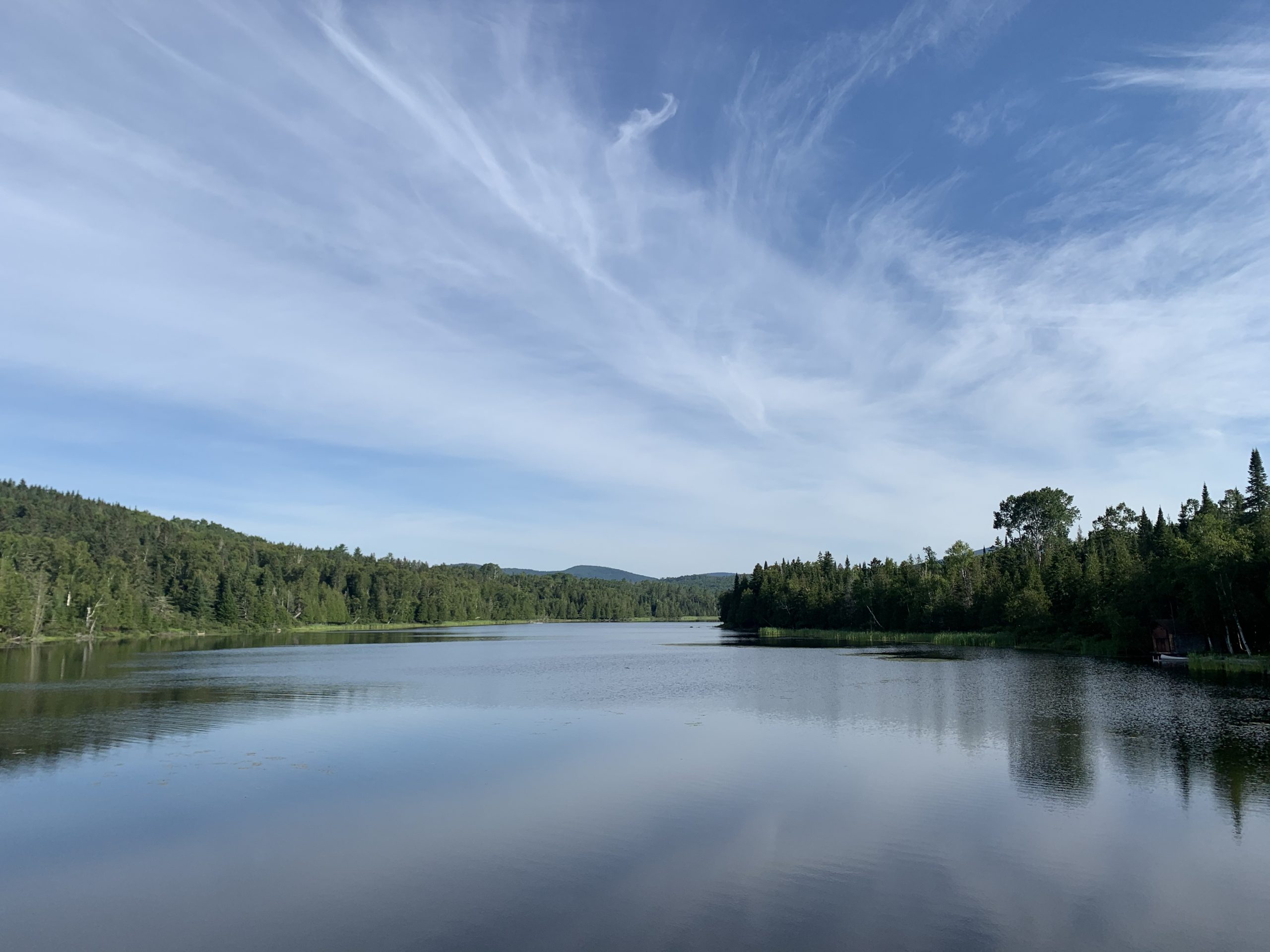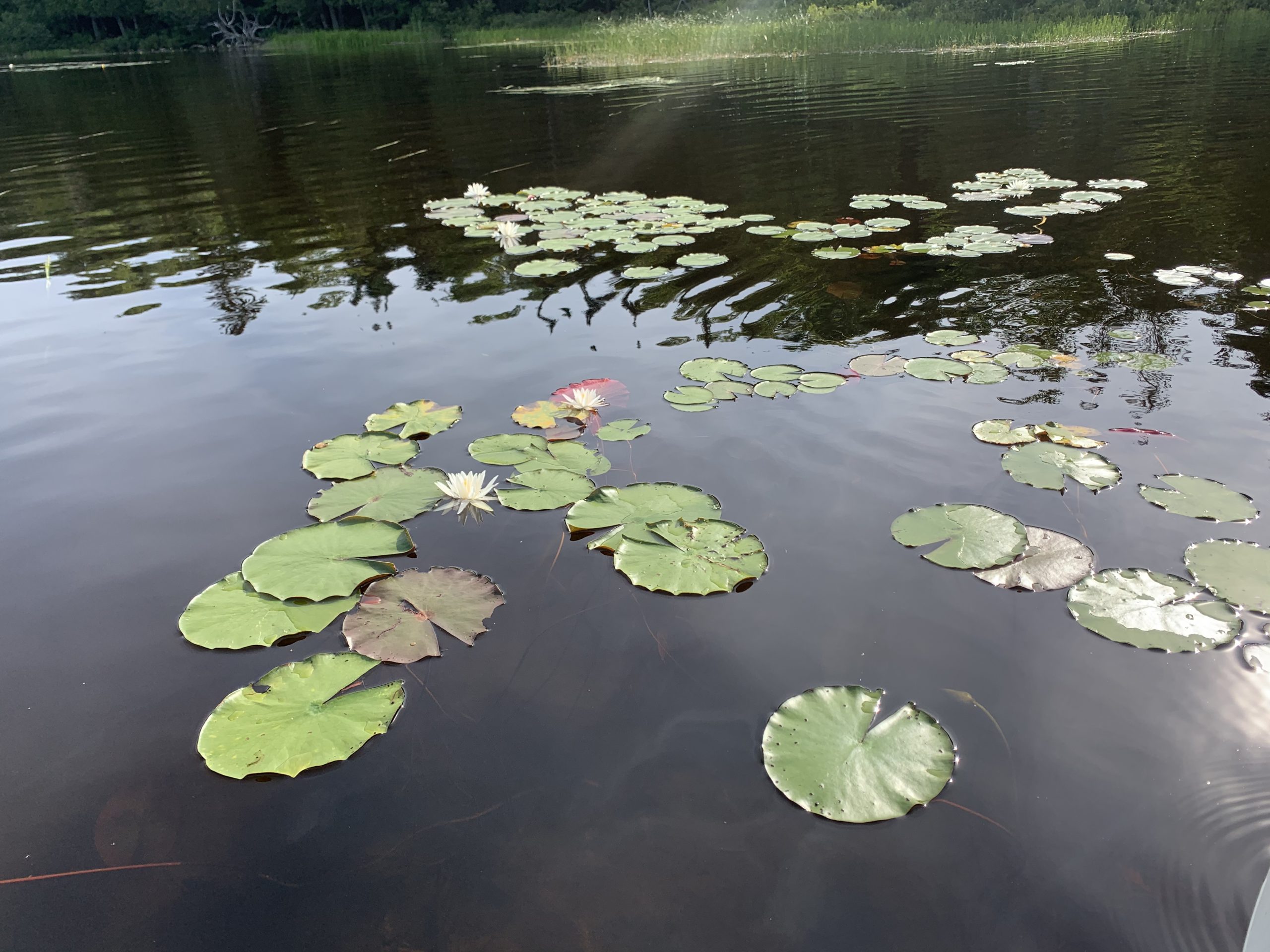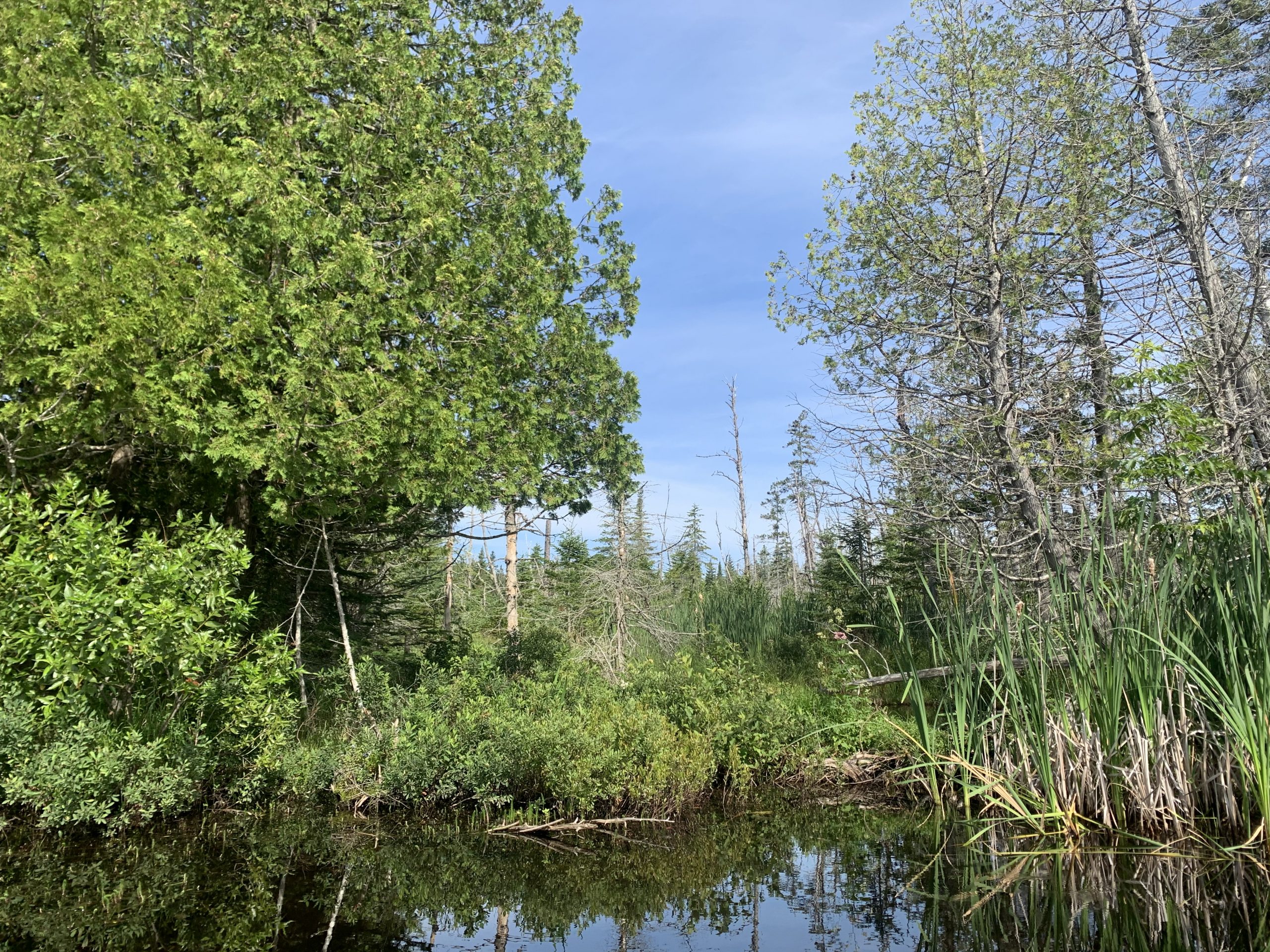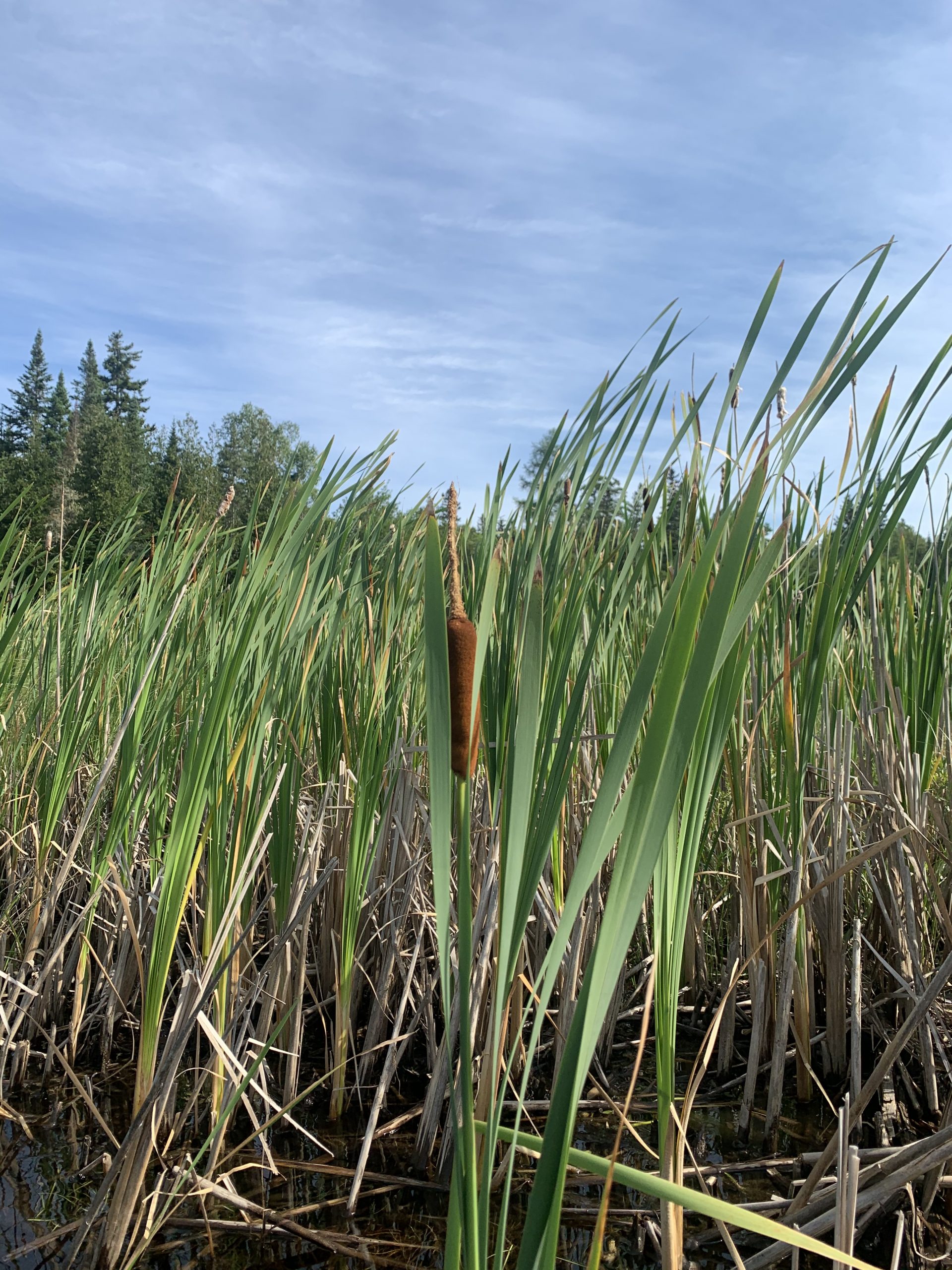
Early morning sun has just topped Saddleback and the high peaks east of Rangeley, as I launch my kayak onto the northern reach of Rangeley Lake known as Hunter Cove. Paddling from the basic boat launch toward the Mingo Loop Road bridge, entrance to this quiet cove, I spot a solitary loon lakeward. Otherwise, at this early hour, I have the water to myself. The water, and the air, are still. There is no sound, save that from the dip of my kayak paddle.
After slipping under the bridge, I paddle to the shadowed waters off the east shore. Shoreline cedar, high pine, white birch, and rock maple line the cove on this side. Rich, soft, light falls on dark blue water, punctuated by lily pads and two types of water lily, one white, one bright yellow. I pass one camp, where all is quiet as well, and soon reach the heart of the cove.
I know of a trail, Hunter Cove Preserve trail, a fine foot-travel route to the cove from Maine Highway 16, managed by the Rangeley Lakes Heritage Trust (RLHT). I have taken this hike many times. It is a short hike, well shaded, a one mile loop, with sub-loops enabling an extended walk if one desires. The ground includes a stand of introduced, reddish-barked, Norway spruce; and an old spring in use in the days when the sloping ground north of Rangeley Lake was sheep country. Ten minutes of paddling draws me even with a small clearing in the woods, and a short dock where trail meets lake. I do not stop, not now, not today. Good water, good light, supreme quiet – I have all the makings for a fine paddling trip. I will walk that trail on another day.

Browse Line
Looking to the west shore, now well lit by the sun, I notice the browse line along the cedars that line the water. The broad-needled cedar appear as though someone trimmed the lower branches to a uniform height of about five feet. This is the work of deer, who graze the favored cedar, particularly in winter.
The browse line is curious to behold, as it can be difficult to discern when up close, but quite clear when seen from a distance – something like standing back when looking at a museum painting, to take in a view of the entire work. I come to Rangeley Lake north shore trails on snowshoes in winter, and have discovered deer who find shelter here from the north winds, water from inlet streams, warmth from the southern exposure near the shore – and ample feed from the abundant cedar.
I paddle on, in a slow but steady rhythm: dip-dip, dip-dip. The kayak slides over the dark water with little sound. The morning unfolds in remarkable beauty, ever-higher sun brightening the hillsides around the cove, and eventually the water itself.


Cattails and Red-winged Blackbirds
At the northern extreme of the cove stand a handful of camps. These, too, are still at this hour. I see no one. My next destination to explore is a stand of cattail that line the waters at the northern end of the cove. Here red winged blackbirds call. One flies out of the midst of the cattails, the distinctive red shoulder patch a clear identifier. I draw close to the cattails themselves, a plant that offers food in many forms, roots to spike, and fronds for weaving – now nearly a lost art. When I time cattail visits right, I have harvested the 3-4 inch green spikes that appear in early July, and steam them like corn on the cob. These look like miniature corn, but are green. They are delicious with butter!
As I work my way along the cattails, a belted kingfisher bursts from a cedar that reaches over the water. This blue and white bird has the peculiar habit of flying away from me by heading in the direction I am going, until out of sight. When I draw again draw near, it flies ahead again. If it really wanted to be rid of me, it could circle around behind me, and be done with my intrusion. But no, on its goes, for nearly a half hour, perching, flying off, perching, flying off, until we near the open waters of Rangeley Lake itself, and it disappears deeper into the woods.
Mid-Cove Discovery
Motion in mid-cove draws my attention. Loons! Two adults and two chicks, bob a hundred feet away from my kayak. I watch from a distance with binoculars. To see loon chicks is one of the more remarkable wildlife sightings in Maine. I watch these little ones paddle along as they learn to get about on their own, following the female loon only a foot or two behind, as though on the end of a short leash. Quite a sight.
Changing water levels, brought on by alternating dry spells and sudden heavy rain storms, are difficult for loons because they nest very near to the water. If the level drops too much, the nest is exposed to marauding land creatures. But if the water quickly rises, the nest may become inundated. For that reason, power boaters should determine where loon-nesting sites are located, and stay well away. Hunter Cove appears to be a favorable loon location. Boaters avoid its shallow waters, and the north-south configuration provides shelter from many a storm.
As I paddle along the west shore, I pass a dock that marks another trail of the Rangeley Lakes Heritage Trust, Hunter Cove Upland. A person could hike on a different trail RLHT trail every day for a week, and enjoy a different trail each day. That is the idea, of course, as Rangeley has positioned itself as a recreation area where visitors – particularly families with children – may do just that.
A breeze picks up, rising off the main lake, out of the south. As the sun hits the water, it warms it, making for a breeze. – fresh on my face and arms. By midday a one-two foot chop could develop out on Rangeley Lake itself. Hunter Cove is usually protected from such strong winds, making it a good choice for a quiet paddle, and for seeing wildlife.

Mountain Views
Dip-dip, dip-dip, glide… An hour and a half of paddling completes a circuit of this set-apart cove, with its loons and black birds and kingfishers, water lilies and cattails.
Oh, yes; I should speak of the mountain views! When heading inland, I enjoy a view of Spotted Mountain, part of the range of mountains and hills that rise north of Rangeley. To the south I have a good look beyond the big lake to the Four Ponds Mountain Range. That range is headwater to South Bog Stream, probably the single richest source of cold, well-oxygenated, brook trout water of all streams flowing into Rangeley Lake.
Much as I treasure a multi-day canoe trip on one of our big waters – the Richardson Lakes, Mooselookmeguntic, Flagstaff, for example – of the waters of the Allagash in far northern Maine, I have a short list of local quiet waters where I like to head in the hours soon after sunrise, or for an evening paddle. Hunter Cove is a favorite.
Paddling Tips
Along with my PFD, which I wear (Rangeley Lake waters are quite cold, even at mid-summer), I have a whistle and a boat horn at the ready. While I encounter no powerboats on this outing, I know that my kayak has a low profile and boaters may not see me as readily as I see them. A toot of the horn alerts a boat that may be approaching too close. The whistle is back up in case the horn fails.
I also carry a standard small kit with a headlamp, fly dope, sunscreen, lip sunscreen, a small snack, and basic first aid for hand blisters and such. Of course I have a water bottle. Why a headlamp? Maine boating law requires that all watercraft – including kayaks and canoes – have a white light available to display between sunset and sunrise. A flashlight is impractical because I need both hands for paddling. The headlamp I put on at nightfall, and it is ready to switch on when I need it.
Other quiet waters? A few of many favorites include Hills Pond, south of Weld; the northeast cove of Porter Lake; Sandy River Ponds; and the North Branch of the Dead River with a launch near Cathedral Pines (The North Branch is Flagstaff Lake water upstream to Eustis dam.)
Rentals of kayaks and canoes are available in Rangeley and Oquossoc. Ask around, and you will find a source readily.
Are you looking for some quiet time as a family; an outing with a dear friend or two; or some peaceful exploring on your own? In Franklin County we have some of the most pristine paddling waters anywhere in America. Enjoy your time on the water!
Text and photos
Copyright 2020
Douglas Allan Dunlap





Wonderful description of your morning nature paddle. Makes one wish snapping fingers signaled the transporter, and we would be there.
What a great story. I’ve been there and it is exactly as written. Great job
Great read on a Monday morning back at the office. Thanks, Doug!
I am right along with you on this water wau “hike.” Thank you.